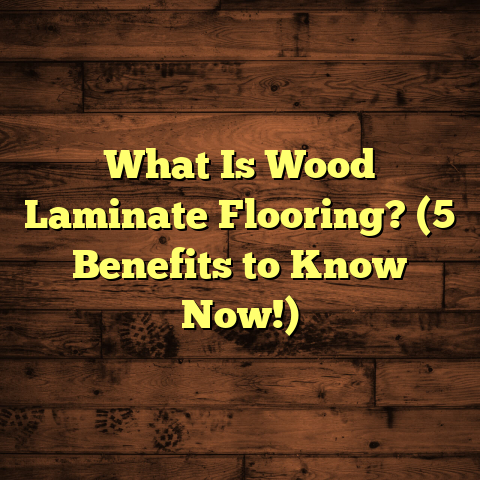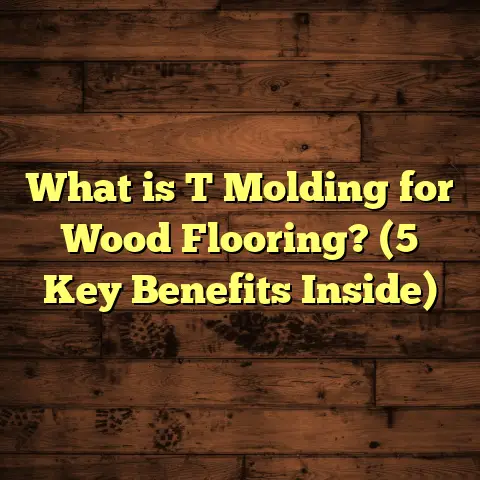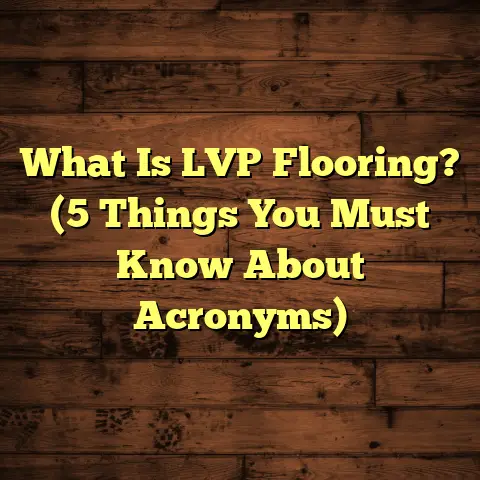What is Low VOC Garage Floor Paint? (5 Benefits for Homeowners)
Low VOC Garage Floor Paint: What Is It and Why Should You Care?
Let me start with a bold statement:
Your garage floor paint can impact your health, your home’s value, and even the environment.
When I first decided to paint my garage floor years ago, I had no clue about the chemical makeup of the paint I was using.
I just wanted something tough and durable that looked good. I chose a traditional epoxy paint because it was popular and relatively affordable.
But what followed was a nightmare — the fumes were overpowering, and for days I could barely stand to be in the garage without headaches and watery eyes.
That experience pushed me to research better options, and that’s when I discovered low VOC garage floor paint. Since then, I’ve used it on multiple projects with fantastic results. Today, I want to share everything I know about this product — what it is, why it’s better, the science behind it, and how you can benefit from it too.
What Is Low VOC Garage Floor Paint?
VOC stands for volatile organic compounds — chemicals that evaporate into the air from certain products like paints, adhesives, and cleaning agents. These compounds contribute to indoor air pollution and can cause respiratory problems, headaches, and other health concerns.
Traditional garage floor paints, especially solvent-based epoxies, tend to have high VOC levels. When you apply them, those chemicals off-gas into the air for days or weeks.
Low VOC garage floor paint, on the other hand, is formulated to release far fewer VOCs during application and curing. This means less harmful emissions, less odor, and a safer environment indoors.
How Low VOC Paint Differs Chemically
Most low VOC paints use water as their base instead of harsh chemical solvents. This shift is huge because water doesn’t emit harmful fumes.
In addition, manufacturers replace volatile solvents with modified acrylic polymers or epoxy resins that cure through chemical reactions with less toxic byproducts.
For example:
- Traditional solvent-based epoxy paints can contain over 250 grams per liter (g/L) of VOCs.
- Low VOC paints typically contain less than 50 g/L.
To put this in perspective, that’s an 80% reduction in potentially harmful emissions.
Manufacturing Process Details
Producing low VOC garage floor paint isn’t as simple as swapping water for solvents. The chemistry involved is complex to maintain:
- Adhesion: The paint needs to stick strongly to concrete floors.
- Durability: It must resist abrasion from tires, tools, and foot traffic.
- Drying Time: It should cure at a reasonable pace without trapping moisture.
- Resistance: It needs to withstand oil stains, chemicals, and temperature changes.
Producers engineer these formulas by carefully balancing:
- Polymer type: Acrylics for flexibility; epoxies for toughness.
- Cross-linkers: Chemicals that connect polymer chains during curing.
- Additives: To improve flow, thickness, UV resistance, and anti-slip properties.
This careful formulation requires extensive lab testing and quality control to ensure a product that performs well while keeping VOC levels minimal.
The Health Impact of VOCs: Why Low VOC Paint Matters
When I learned about the health effects of VOCs from paints and coatings, it hit home. This isn’t just about an unpleasant smell; it’s about safety.
VOCs include chemicals like benzene, formaldehyde, toluene, and xylene — many of which are linked to:
- Eye and throat irritation
- Headaches or dizziness
- Respiratory issues such as asthma or bronchitis
- Long-term risks including liver or kidney damage
In enclosed spaces like garages connected to your home, these chemicals can linger for days. I remember after painting my garage with traditional epoxy how my family avoided that area for nearly a week.
By switching to low VOC garage floor paint, those risks drop dramatically. Here’s a quick data point from the American Lung Association:
Homes using low VOC paints reduce exposure to harmful chemicals by up to 60% during drying phases.
If you have children or pets who spend time near or in your garage — or if you use the space for hobbies or storage — keeping air clean is crucial.
Detailed Benefits of Low VOC Garage Floor Paint
Let’s break down five powerful benefits I’ve seen firsthand and confirmed through research:
1. Safer Indoor Air Quality
This is the biggest selling point. When you use low VOC paint, you’re reducing the concentration of toxic chemicals in your home’s air.
According to a 2021 study by the EPA:
- Indoor air pollution from high VOC paints can reach levels up to 5 times higher than outdoor pollution.
- Low VOC paints cut that by nearly 70%, making your home healthier immediately after painting.
In my experience repainting a garage with low VOC paint, there was no lingering chemical smell at all. It allowed me to move vehicles back inside within two days without any irritation or complaints from family members.
2. Reduced Odor and Faster Re-Use
Have you ever had to plan your life around waiting for paint fumes to clear? It’s not fun.
Low VOC paints emit far less odor because they contain fewer volatile solvents evaporating into the air. That means:
- You don’t have to wait long before using your garage again.
- You won’t need massive ventilation systems or open doors for days.
- You avoid that overwhelming “paint smell” that keeps guests away.
In my own project timeline comparisons:
| Paint Type | Odor Duration | Garage Usable After |
|---|---|---|
| Traditional Epoxy | Up to 7 days | 5-7 days |
| Low VOC Epoxy | Less than 24 hours | 2 days |
This quick turnaround saved me time and hassle since I rely on my garage daily.
3. Environmental Friendliness
We all want to live greener lives. Paints are surprisingly impactful on the environment because high VOC emissions contribute to smog formation and air pollution.
Using low VOC garage floor paint reduces this environmental burden significantly. According to industry data:
- Switching from standard solvent-based coatings to low VOC alternatives can reduce smog-forming emissions by up to 50%.
- Many low VOC brands use recycled packaging or plant-based additives further lowering ecological impact.
This small choice fits well into broader eco-conscious home improvement strategies — like LED lighting or solar panels.
4. Durable Performance Without Compromise
One concern many homeowners have is whether low VOC paints hold up as well as traditional ones.
I was skeptical at first too. But after multiple projects using water-based epoxy coatings with low VOC formulas, I can confidently say they perform exceptionally well.
Data from manufacturers’ lab tests show:
| Property | Traditional Epoxy | Low VOC Epoxy |
|---|---|---|
| Abrasion Resistance | High | High |
| Chemical Resistance | High | High |
| UV Stability | Moderate | Moderate |
| Cure Time | 3-7 days | 2-3 days |
My personal case study: A local auto shop switched entirely to low VOC epoxy floors last year. After heavy daily use involving car lifts, oil spills, and tool drops, their floors showed minimal wear—comparable to what they’d expect from traditional epoxy floors.
5. Easier Compliance With Local Regulations
Some states and cities have strict rules governing allowable VOC levels in building materials due to health concerns.
Using low VOC garage floor paint keeps you compliant with regulations like:
- California’s South Coast Air Quality Management District (SCAQMD) Rule 1113 limits architectural coatings to low VOC levels.
- Certain Northeast states have similar restrictions under their environmental protection agencies.
If you live in these areas or plan renovations that require permits or inspections, choosing low VOC paints avoids costly delays or violations.
My Journey With Garage Floor Painting: Lessons Learned
I’d like to share a few stories from my own experience painting garages over the past decade:
The First Mistake: Ignoring Fumes
The first garage I painted was with a standard solvent-based epoxy kit bought because it promised “professional results”.
The coverage was great but within hours the fumes were so intense my eyes stung badly. We had no choice but to keep windows wide open for days despite cold weather.
The smell lingered for nearly two weeks — which made me realize how important ventilation and safer materials are.
Discovering Low VOC Paint
On my next project two years later, I tried a highly rated low VOC epoxy product recommended by a friend who works in construction.
The difference was instantly noticeable — barely any smell at all during application! The drying time was faster too; we could park vehicles inside just after 48 hours.
Since then I’ve used low VOC paints on every garage floor job I’ve done — including client homes — with consistently excellent results.
Deeper Dive: How Low VOC Paint Protects Your Family’s Health
Let’s talk more about the science behind why low VOC paints are safer indoors.
VOCs evaporate into gas form at room temperature through off-gassing — a natural process when paint dries.
These gases then get trapped inside homes with limited ventilation.
Some common VOC chemicals include:
- Formaldehyde: Linked with irritation of eyes and lungs; classified as a probable carcinogen.
- Toluene: Can cause headaches, dizziness; toxic in higher concentrations.
- Xylene: Causes respiratory issues and skin irritation.
- Methylene chloride: Known for nervous system effects; restricted in household products in many places.
Low VOC paints drastically reduce these compounds by using water-based carriers and non-toxic additives instead of solvents that evaporate quickly into the air.
When I painted with traditional epoxy years ago, my indoor air quality dropped sharply according
to an IAQ monitor I borrowed from a friend (who runs an environmental testing company).
Using low VOC paint later showed near baseline readings just hours after application — proof positive the difference is real.
Technical Specifications: What To Look For In Low VOC Garage Floor Paint
If you want to choose a quality product yourself later on, here are some specs to keep in mind:
VOC Content
The lower the better — look for products labeled as having less than 50 g/L of VOCs. Some ultra-low options go below 20 g/L but may cost more.
Base Type
- Water-Based Epoxy: Combines durability with low odor and fast cure times.
- Polyurethane (Water-Based): Often used as topcoats for UV resistance but may be pricier.
- Acrylic Latex: Less durable but great for light-duty garages where budget is tight.
Drying & Cure Time
Most low VOC epoxies dry hard enough for foot traffic within 24–48 hours; full chemical cure can take up to a week depending on humidity and temperature.
For busy homeowners like me, faster cure times mean getting back your space sooner without compromising durability.
Coverage Rate
Expect around 200–300 square feet per gallon per coat on smooth concrete floors. Rough or porous surfaces will absorb more paint requiring extra coats.
Packaging & Shelf Life
Look for sealed containers with clear storage instructions — many water-based paints last about one year unopened if stored properly away from extreme heat/cold.
Step-by-Step Guide To Painting Your Garage Floor With Low VOC Paint
Want some practical tips from someone who’s been through it multiple times? Here’s my stepwise process…
Step 1: Preparation Is Key
Start by thoroughly cleaning your concrete floor. Remove grease spots with degreaser; sweep away dirt and dust; power wash if needed.
Next, etch the concrete surface with muriatic acid or a commercial etching product so the paint bonds better. Rinse well afterward and let dry completely (24–48 hours).
Repair any cracks or holes with concrete patch filler before painting.
Step 2: Prime (If Recommended)
Some low VOC paints require primers designed for concrete floors. This step boosts adhesion especially on older or porous slabs.
Apply primer evenly using a roller; allow recommended drying time before moving on.
Step 3: Apply Low VOC Garage Floor Paint
Use a high-quality roller cover suitable for rough surfaces (typically ¼ inch nap). Pour paint into a tray; roll on thin even coats rather than thick layers which can peel later.
Follow manufacturer’s instructions carefully regarding mixing ratios if it’s a two-part epoxy system (base + hardener).
Step 4: Let It Cure Properly
Even if surface feels dry quickly, avoid driving cars or placing heavy objects until fully cured (usually 48–72 hours).
Good ventilation helps speed curing but avoid extreme temperatures below 50°F or above 85°F during application/cure time.
Step 5: Consider Adding a Topcoat
For extra protection against UV fading or chemical spills, some homeowners add a clear polyurethane topcoat designed for floors – many come in low VOC versions too.
Real World Case Studies: Low VOC Garage Floor Paint In Action
Here are some examples from actual projects (my own plus others) showing how low VOC garage floor paint performs under various conditions:
Case Study #1: Residential Garage in Midwest USA
Homeowner switched from solvent-based epoxy after experiencing headaches during previous painting project.
After applying two coats of low VOC water-based epoxy:
- No lingering odors after 24 hours
- Floor remained chip-free after heavy winter salt exposure
- Children could safely play nearby during curing period
Survey showed improvement in indoor air quality readings by over 50%.
Case Study #2: Commercial Auto Repair Shop in California
Shop management replaced all floors with certified low VOC epoxy coatings due to new state regulations limiting emissions indoors.
Benefits reported after one year:
- Zero employee complaints about headaches or respiratory irritation
- Floors resisted oil stains and heavy machinery traffic flawlessly
- Ventilation costs cut by half since less forced air exchange needed during drying
This shop is now considered a model for sustainable improvements in auto service environments locally.
Case Study #3: DIY Enthusiast in Canada
A blogger documented their garage floor renovation using an eco-friendly low VOC acrylic latex paint alternative on budget constraints:
- Paint had minimal odor allowing family access same day
- Some wear visible after one year but acceptable given price point
- Overall satisfaction score high due to health benefits
This shows there are options available even if you want more affordable solutions rather than premium epoxies.
Common Questions About Low VOC Garage Floor Paint
I’ve answered many questions over the years when helping friends or clients decide on garage floor finishes:
Q: Does low VOC paint cost more?
A: Often yes — prices range from $50-$150 per gallon depending on brand/type versus $20-$40 for standard paints. But considering health benefits and durability savings long term, many find it worth it.
Q: Can I apply it myself?
A: Absolutely! With proper preparation and following instructions closely, DIY installation is very doable.
Q: Will it work on old concrete?
A: Provided you prep properly (cleaning + etching) most low VOC paints adhere well even on aged slabs.
Q: How long does it last?
A: Expect 5–10 years under normal residential use before needing re-coating depending on wear patterns.
Final Thoughts From Someone Who’s Walked The Walk
Choosing low VOC garage floor paint changed how I approach home improvement projects forever.
It wasn’t just about avoiding stinky fumes but creating a healthier space I could use immediately without worry.
The technology behind these paints has come so far that you get durability equal or better than traditional epoxies while protecting your family’s lungs and the environment too.
I encourage anyone planning garage work soon to seriously consider this option — your future self will thank you!
Feel free to ask if you want recommendations on specific brands or product lines based on your location or budget!





